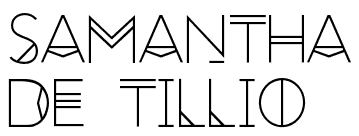articles
"On the Precipice: Sibylle Peretti's explorations of industrial encroachment on the wild American landscape call to mind Thomas Cole's Hudson River School Paintings"
Published by GLASS: The UrbanGlass Art Quarterly (Summer 2024)
Published by GLASS: The UrbanGlass Art Quarterly (Summer 2024)
"Post-Disiplinary Practice: Performative Glass Today"
Published by GLASS: The UrbanGlass Art Quarterly (Winter 2023)
In this final installment of a three-part series exploring the relationship between glass and performance from the twentieth century to today, I seek to illuminate the current state of the field. Of course, a complete analysis is impossible within the constraints of this or any piece of writing, so the topics and artists discussed constitute a representation of an expanding field. The work and artists represented within this article are offered in service of this discussion, and constitute a sample of case studies illustrating my conclusions regarding this ever-changing field of post-disciplinary praxis. In conclusion, this final installment serves to illustrate the rich variety and deep commitment to an aspect of creative practice within the field of contemporary glass, which is increasingly central to the work of many artists, especially a new generation of practitioners.
Published by GLASS: The UrbanGlass Art Quarterly (Winter 2023)
In this final installment of a three-part series exploring the relationship between glass and performance from the twentieth century to today, I seek to illuminate the current state of the field. Of course, a complete analysis is impossible within the constraints of this or any piece of writing, so the topics and artists discussed constitute a representation of an expanding field. The work and artists represented within this article are offered in service of this discussion, and constitute a sample of case studies illustrating my conclusions regarding this ever-changing field of post-disciplinary praxis. In conclusion, this final installment serves to illustrate the rich variety and deep commitment to an aspect of creative practice within the field of contemporary glass, which is increasingly central to the work of many artists, especially a new generation of practitioners.
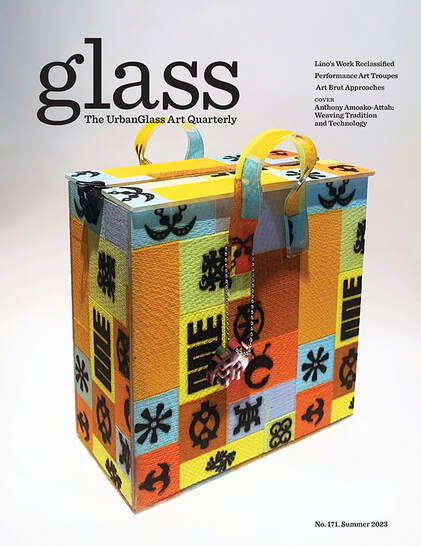
"Live Glass at the Turn of the Millennium: The Performance Troupe"
Published by GLASS: The UrbanGlass Art Quarterly (Summer 2023)
Over the course of twenty-five years, from 1990 to 2015, multiple collaborative artist groups were established to explore the performative aspects of the craft. The best-known include the B Team (1990-98), the Butter Eaters (1999-2014), the Burnt Asphalt Family (est. 2007), Cirque de Verre (2008-10), the Glass Theater (2012-13), and Flock the Optic (est. 2014). Unified by a desire to explore non-objective process and transcend the educational demonstration–-building on its inherent spectacle–-each of these groups approached their foray into the performative with a unique set of artistic concerns, aesthetics, and goals. Some have since disbanded, members returning to their individual practice, to open galleries, or to work in institutions, however some continue, expanding as new collaborators join original founders. Together these troupes, teams, and projects have created an ecosystem within the greater field of contemporary glass art that is increasingly relevant today.
Published by GLASS: The UrbanGlass Art Quarterly (Summer 2023)
Over the course of twenty-five years, from 1990 to 2015, multiple collaborative artist groups were established to explore the performative aspects of the craft. The best-known include the B Team (1990-98), the Butter Eaters (1999-2014), the Burnt Asphalt Family (est. 2007), Cirque de Verre (2008-10), the Glass Theater (2012-13), and Flock the Optic (est. 2014). Unified by a desire to explore non-objective process and transcend the educational demonstration–-building on its inherent spectacle–-each of these groups approached their foray into the performative with a unique set of artistic concerns, aesthetics, and goals. Some have since disbanded, members returning to their individual practice, to open galleries, or to work in institutions, however some continue, expanding as new collaborators join original founders. Together these troupes, teams, and projects have created an ecosystem within the greater field of contemporary glass art that is increasingly relevant today.
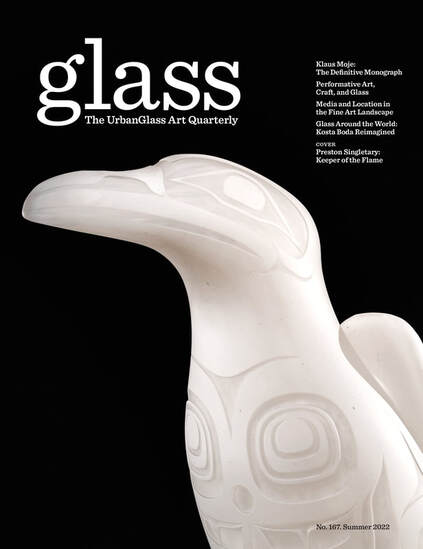
“Cold and Hot: Performative Art, Craft, and Glass in the 20th Century"
Published by GLASS: The UrbanGlass Art Quarterly (Summer 2022)
Defining performance in relation to glass or glass in relation to performance is a process of tracing various threads and accepting the impossibility of one linear narrative. An ephemeral, non-objective approach to glass making has prevailed during the twenty-first century and artists working over the past two decades have been particularly drawn to this mode of making. However, origins of the relationship between contemporary glass and performance is evident in the artwork of the 1960s and 1970s. In the United States, during this period, there were three primary performative approaches to working with glass: the use of plate glass in body art as documented through photography; the live demonstration, which highlighted the choreographic quality inherent to glass blowing; and avant-garde activations of the material through combination with sound, video, and stage performance.
Published by GLASS: The UrbanGlass Art Quarterly (Summer 2022)
Defining performance in relation to glass or glass in relation to performance is a process of tracing various threads and accepting the impossibility of one linear narrative. An ephemeral, non-objective approach to glass making has prevailed during the twenty-first century and artists working over the past two decades have been particularly drawn to this mode of making. However, origins of the relationship between contemporary glass and performance is evident in the artwork of the 1960s and 1970s. In the United States, during this period, there were three primary performative approaches to working with glass: the use of plate glass in body art as documented through photography; the live demonstration, which highlighted the choreographic quality inherent to glass blowing; and avant-garde activations of the material through combination with sound, video, and stage performance.
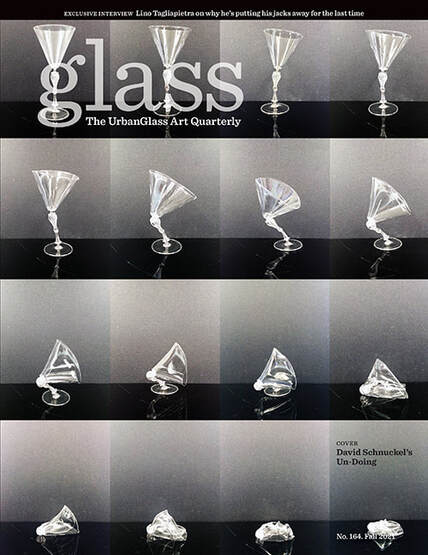
"Flow: Marvin Lipofsky was profoundly influenced by the anti-war and Funk Art movements around him, but never lost his singular focus on exploring sculptural forms in glass."
Published by GLASS: The UrbanGlass Art Quarterly (Fall 2021)
Marvin Lipofsky arrived at glass at a crucial moment when artists in the United States were beginning to develop ways of working with the material artistically, rather than at factory scale. He became a key figure in the studio glass movement, bringing to the medium his vision of a sculptural, abstract, and expressive approach, taken in part from contemporary ceramics. In the 1960s, when other artists were preoccupied with perfecting vessel forms or achieving certain skills, Lipofsky was busy exploring new shapes and forms. This is not to say that he wasn’t concerned with technique, because he was and eventually developed his own artistic mastery. However, rather than beginning his path in glass as a craftsperson, Lipofsky came to the material already an artist.
Read more →
Published by GLASS: The UrbanGlass Art Quarterly (Fall 2021)
Marvin Lipofsky arrived at glass at a crucial moment when artists in the United States were beginning to develop ways of working with the material artistically, rather than at factory scale. He became a key figure in the studio glass movement, bringing to the medium his vision of a sculptural, abstract, and expressive approach, taken in part from contemporary ceramics. In the 1960s, when other artists were preoccupied with perfecting vessel forms or achieving certain skills, Lipofsky was busy exploring new shapes and forms. This is not to say that he wasn’t concerned with technique, because he was and eventually developed his own artistic mastery. However, rather than beginning his path in glass as a craftsperson, Lipofsky came to the material already an artist.
Read more →

"Norwood Viviano: Re-Cast Cities"
Published by GLASS: The UrbanGlass Art Quarterly (Summer 2021)
American artist Norwood Vivano’s exhibition “Re-cast Cities” is the most recent iteration of a decade-long project that investigates the development of the United States metropolis. Considering the American urban center through various perspectives including immigration, industry, population, and climate change, Viviano asks us to consider the shoulders upon which cities such as Pittsburgh, Houston, and Portland stand, as well as the vulnerability they face in the changing landscape of the twenty-first century.
Read more →
Published by GLASS: The UrbanGlass Art Quarterly (Summer 2021)
American artist Norwood Vivano’s exhibition “Re-cast Cities” is the most recent iteration of a decade-long project that investigates the development of the United States metropolis. Considering the American urban center through various perspectives including immigration, industry, population, and climate change, Viviano asks us to consider the shoulders upon which cities such as Pittsburgh, Houston, and Portland stand, as well as the vulnerability they face in the changing landscape of the twenty-first century.
Read more →
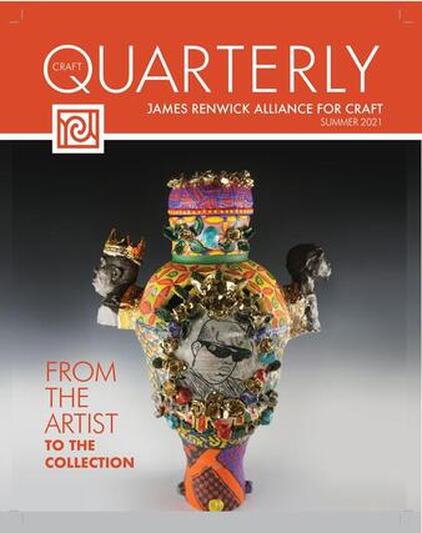
"The Legacy of Paul J. Smith: Artist, Curator, MAD Museum Director"
Published by Craft Quarterly: James Renwick Alliance for Craft (Summer 2021)
When remembering Paul J. Smith, it’s impossible to
untwine his professional legacy from the history of the Museum of Arts and Design (MAD) and its collection. Smith became involved in the institution during its earliest years and went on to become the Museum’s longest-tenured Director, setting the tone for the curatorial and educational programming for decades to come.
Read more →
Published by Craft Quarterly: James Renwick Alliance for Craft (Summer 2021)
When remembering Paul J. Smith, it’s impossible to
untwine his professional legacy from the history of the Museum of Arts and Design (MAD) and its collection. Smith became involved in the institution during its earliest years and went on to become the Museum’s longest-tenured Director, setting the tone for the curatorial and educational programming for decades to come.
Read more →

"Allegory and Apparatus" by Lukas Milanak
Published by GLASS: The UrbanGlass Art Quarterly (Winter 2020/2021)
Milanak works at the crossroads of art and science, fiction and truth, elemental transformation and a DIY ethos. Art and science combine to create imaginative realities that provoke inquiry into the nature of the world and its truths. Milanak’s constructions operate through the lens of speculative fiction, where a
post-cataclysmic world has led to a revived interest in alchemy, inquiries into
nonverbal communication between
humans and plants, and non-biological
alternatives to species extinction.
Read more →
Published by GLASS: The UrbanGlass Art Quarterly (Winter 2020/2021)
Milanak works at the crossroads of art and science, fiction and truth, elemental transformation and a DIY ethos. Art and science combine to create imaginative realities that provoke inquiry into the nature of the world and its truths. Milanak’s constructions operate through the lens of speculative fiction, where a
post-cataclysmic world has led to a revived interest in alchemy, inquiries into
nonverbal communication between
humans and plants, and non-biological
alternatives to species extinction.
Read more →

"Glass, Meet the Future" Film Festival
Published by GLASS: The UrbanGlass Art Quarterly (Fall 2020)
In many ways, glass and film are natural partners. Both are mediums that deal with optic qualities, light, and ephemerality, and historically film requires glass, in the form of plates and lenses. As a result the marriage of creative practices seems surprisingly natural.
Read more →
Published by GLASS: The UrbanGlass Art Quarterly (Fall 2020)
In many ways, glass and film are natural partners. Both are mediums that deal with optic qualities, light, and ephemerality, and historically film requires glass, in the form of plates and lenses. As a result the marriage of creative practices seems surprisingly natural.
Read more →
 Courtesy Museum of Arts and Design; photo by Jenna Bascon
Courtesy Museum of Arts and Design; photo by Jenna Bascon
"Unpacking the Green Book -- Reading List"
Featured as a library in Unpacking the Green Book: Travel and Segregation in Jim Crow America, Museum of Arts and Design, March 1 to April 8, 2018
In the wake of the protests against police brutality and Black Lives Matter demonstrations that are sweeping our nation, against a backdrop of Covid-19, which has brought to light in stark transparency the racial inequities and injustices of the United States, I’d like to share a reading list that I originally compiled for the educational exhibition Unpacking the Green Book: Travel and Segregation in Jim Crow America (Museum of Arts and Design, March 1 to April 8, 2018). This list includes a variety of texts that discuss aspects of systemic racism in the United States and has been expanded to include additional works that investigate contemporary life, and literature, because learning about another’s experience through art creates empathy. I hope this list can help facilitate hard yet necessary conversations around the history of race relations and systems oppression in the United States.
Read more →
Featured as a library in Unpacking the Green Book: Travel and Segregation in Jim Crow America, Museum of Arts and Design, March 1 to April 8, 2018
In the wake of the protests against police brutality and Black Lives Matter demonstrations that are sweeping our nation, against a backdrop of Covid-19, which has brought to light in stark transparency the racial inequities and injustices of the United States, I’d like to share a reading list that I originally compiled for the educational exhibition Unpacking the Green Book: Travel and Segregation in Jim Crow America (Museum of Arts and Design, March 1 to April 8, 2018). This list includes a variety of texts that discuss aspects of systemic racism in the United States and has been expanded to include additional works that investigate contemporary life, and literature, because learning about another’s experience through art creates empathy. I hope this list can help facilitate hard yet necessary conversations around the history of race relations and systems oppression in the United States.
Read more →

"Backwater" by Sibylle Peretti
Published by GLASS: The UrbanGlass Art Quarterly (Summer 2020)
In New Orleans, where the artist now lives, the edgelands are spaces of turbulent transformation, where indigenous artifacts and urban detritus alike are washed in and out by flooding, resulting in a landscape in constant flux. The exhibition’s title, “Backwater” (and a 2020 work of the same name), references the puddles that result from these floods—underseen, yet with their own beauty and ability to contain expansive, if miniscule, ecosystems.
Read more →
Published by GLASS: The UrbanGlass Art Quarterly (Summer 2020)
In New Orleans, where the artist now lives, the edgelands are spaces of turbulent transformation, where indigenous artifacts and urban detritus alike are washed in and out by flooding, resulting in a landscape in constant flux. The exhibition’s title, “Backwater” (and a 2020 work of the same name), references the puddles that result from these floods—underseen, yet with their own beauty and ability to contain expansive, if miniscule, ecosystems.
Read more →

"The Secret: Keep Going: Liza Lou, who endured rejection and dismissal for her monumental glass-beaded work Kitchen, launches an online collaborative project to foster community in a time of isolation."
Published by GLASS: The UrbanGlass Art Quarterly (Summer 2020)
Surviving the labor involved in the making of a work can only be [accomplished] in the doing, in the practical, the day-to-day, ticking off the to-do list, doing what can be done in a single day, and finding value in the process. ... I suffered from a sense of overwhelm—by the end of the five years’ working, it was too much of a too much, and I worried that I had swum out too far and wouldn’t be able to swim back to shore. I did, though, and lived to tell the tale.
Read more →
Published by GLASS: The UrbanGlass Art Quarterly (Summer 2020)
Surviving the labor involved in the making of a work can only be [accomplished] in the doing, in the practical, the day-to-day, ticking off the to-do list, doing what can be done in a single day, and finding value in the process. ... I suffered from a sense of overwhelm—by the end of the five years’ working, it was too much of a too much, and I worried that I had swum out too far and wouldn’t be able to swim back to shore. I did, though, and lived to tell the tale.
Read more →
 Photo courtesy American Craft Council Library & Archives
Photo courtesy American Craft Council Library & Archives
Remembering Paul J. Smith
Published by the Museum of Arts and Design (Spring 2020)
A painter, ceramist, jewelry artist, and woodworker, Smith’s background as an artist informed the way he thought about his work at the Museum, including the exhibitions he curated and his ideas about the function of museums in public life. In an oral history for Bard Graduate Center, Smith recalled, "When I became director and was thinking, 'Well, what is the role of this museum?' I felt very comfortable about it being an institution focused on reporting on the new. ... [T]he main focus was being a showplace in New York for this emerging, outstanding innovative work from around the country, and some selected work from abroad."
Read more →
Published by the Museum of Arts and Design (Spring 2020)
A painter, ceramist, jewelry artist, and woodworker, Smith’s background as an artist informed the way he thought about his work at the Museum, including the exhibitions he curated and his ideas about the function of museums in public life. In an oral history for Bard Graduate Center, Smith recalled, "When I became director and was thinking, 'Well, what is the role of this museum?' I felt very comfortable about it being an institution focused on reporting on the new. ... [T]he main focus was being a showplace in New York for this emerging, outstanding innovative work from around the country, and some selected work from abroad."
Read more →

"Kitchen" by Liza Lou
Published by GLASS: The UrbanGlass Art Quarterly (Spring 2020)
[Kitchen] is a life-size replica of a kitchen complete with a cherry pie in the oven, dirty dishes overflowing in the sink, and cereal, milk, and toast on a checkered tablecloth. However, this quotidian scene of Americana has been painstakingly covered with glass seed beads, one by one, with tweezers, by the artist, over the course of five years. The unimaginable amount of (female) labor that birthed this project is itself the work’s core message, but its ability to evoke a nuanced conversation around ideas of domesticity, gender, popular culture, beauty, devotion, and labor is what has allowed it to transcend the vastly changing landscape of culture and feminism at the turn of the 21st century.
Read more →
Published by GLASS: The UrbanGlass Art Quarterly (Spring 2020)
[Kitchen] is a life-size replica of a kitchen complete with a cherry pie in the oven, dirty dishes overflowing in the sink, and cereal, milk, and toast on a checkered tablecloth. However, this quotidian scene of Americana has been painstakingly covered with glass seed beads, one by one, with tweezers, by the artist, over the course of five years. The unimaginable amount of (female) labor that birthed this project is itself the work’s core message, but its ability to evoke a nuanced conversation around ideas of domesticity, gender, popular culture, beauty, devotion, and labor is what has allowed it to transcend the vastly changing landscape of culture and feminism at the turn of the 21st century.
Read more →

"LUMINA" by Ritsue Mishima
Published by GLASS: The UrbanGlass Art Quarterly (Winter 2019/20).
Mishima’s ethereal, colorless glass forms are the poetic embodiment of
light and movement. As breath is forced in, and the heat of the molten material expands the interior air, the glass swells. ... the glass swirls and twists in a deceptively peaceful monsoon. The works ... embody the
tension inherent to the material: its transfigurative ability to capture a fleeting moment, move from liquid to solid, yet maintain the vitality of a material in motion.
Read more →
Published by GLASS: The UrbanGlass Art Quarterly (Winter 2019/20).
Mishima’s ethereal, colorless glass forms are the poetic embodiment of
light and movement. As breath is forced in, and the heat of the molten material expands the interior air, the glass swells. ... the glass swirls and twists in a deceptively peaceful monsoon. The works ... embody the
tension inherent to the material: its transfigurative ability to capture a fleeting moment, move from liquid to solid, yet maintain the vitality of a material in motion.
Read more →
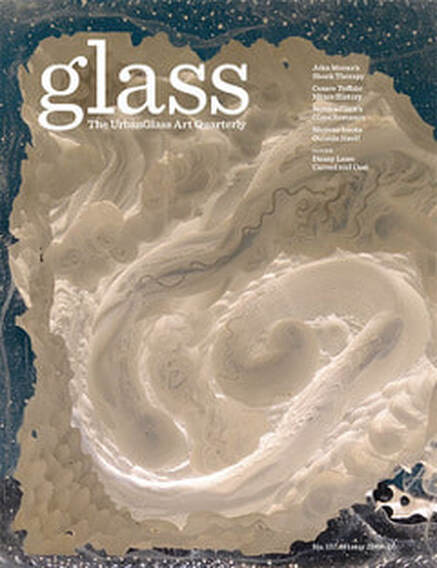
"Reverie Forest: Sanctuary for Strange Creatures" by Erica Rosenfeld
Published by GLASS: The UrbanGlass Art Quarterly (Winter 2019/20).
In Reverie Forest: Sanctuary for Strange Creatures, the vestiges of [midcentury] paint-by-number kits used by Rosenfeld are reconstructed. ... The artist becomes Dr. Frankenstein, splicing and stitching together elements of animals, humans, saints, and art-historical references, though the results are more celebratory than unsettling. Her "Sanctuary for Strange Creatures" thus acts as a beacon of resistance against a dangerously rose-colored look at the past.
Read more →
Published by GLASS: The UrbanGlass Art Quarterly (Winter 2019/20).
In Reverie Forest: Sanctuary for Strange Creatures, the vestiges of [midcentury] paint-by-number kits used by Rosenfeld are reconstructed. ... The artist becomes Dr. Frankenstein, splicing and stitching together elements of animals, humans, saints, and art-historical references, though the results are more celebratory than unsettling. Her "Sanctuary for Strange Creatures" thus acts as a beacon of resistance against a dangerously rose-colored look at the past.
Read more →

"Torching the Past: Using flame as a scalpel, Amber Cowan deconstructs kitchy decorative glassware to create entirely new, fantastical landscapes that interweave history and contemporary issues."
Published by Glass: The UrbanGlass Art Quarterly (Fall 2019).
Amber Cowan’s glass sculptures are resplendent assemblages reworked from vintage glass tableware. Wielding her torch, the artist deconstructs decorative glass, remaking [them] as complex narrative vignettes, sculptures, or color-field “paintings.” The work demands slow
observation and challenges preconceived stereotypes regarding ornamentation, femininity, and the dominance of modernism.
Read more →
Published by Glass: The UrbanGlass Art Quarterly (Fall 2019).
Amber Cowan’s glass sculptures are resplendent assemblages reworked from vintage glass tableware. Wielding her torch, the artist deconstructs decorative glass, remaking [them] as complex narrative vignettes, sculptures, or color-field “paintings.” The work demands slow
observation and challenges preconceived stereotypes regarding ornamentation, femininity, and the dominance of modernism.
Read more →

"Memoria Technica: Old Venetian Glass" by Kim Harty
Published by GLASS: The UrbanGlass Quarterly (Summer 2019).
Kim Harty’s work exists in a liminal space between craft and performance. The artist has dedicated her practice to breaking the boundaries of glass as a material for art making, primarily through ephemeral experimentations into its expansive possibilities. ... As a result, movement and the body are essential elements of Harty’s relationship to her chosen medium, and in her current exhibition at Heller Gallery.
Read more →
Published by GLASS: The UrbanGlass Quarterly (Summer 2019).
Kim Harty’s work exists in a liminal space between craft and performance. The artist has dedicated her practice to breaking the boundaries of glass as a material for art making, primarily through ephemeral experimentations into its expansive possibilities. ... As a result, movement and the body are essential elements of Harty’s relationship to her chosen medium, and in her current exhibition at Heller Gallery.
Read more →

"Mechanical Magic: The Automata of Brittany Cox"
Published by Metalsmith 39.2 (Spring 2019).
Brittany Cox is a seventeenth-century mechanic –– or more officially, an antiquarian horologist. She specializes in complicated clocks, watches, and objects that include an additional layer of function: music, repeating mechanisms, automata, or mechanical magic. She inhabits a world of objects and materials unconsidered for the most part in our contemporary lives. ... Few hand skills and processes are more specialized than the type of complex horology that she is working tirelessly to keep alive.
Read more →
Published by Metalsmith 39.2 (Spring 2019).
Brittany Cox is a seventeenth-century mechanic –– or more officially, an antiquarian horologist. She specializes in complicated clocks, watches, and objects that include an additional layer of function: music, repeating mechanisms, automata, or mechanical magic. She inhabits a world of objects and materials unconsidered for the most part in our contemporary lives. ... Few hand skills and processes are more specialized than the type of complex horology that she is working tirelessly to keep alive.
Read more →

“Tomás Saraceno: Solar Rhythms”
Published by GLASS: The UrbanGlass Quarterly (Fall 2018).
Tomás Saraceno ... has been responding to the climate crisis by proposing new, sustainable ways of inhabiting the environment for over 15 years. The artist, who sees himself working in the tradition of visionary Buckminster Fuller, works across the disciplines of art, architecture, natural sciences, and engineering to create floating sculptures, community projects, and interactive installations that redefine humans’ relationship to the planet and the possibilities of alternative living in a post-fossil fuel era.
Read more → [TK]
Published by GLASS: The UrbanGlass Quarterly (Fall 2018).
Tomás Saraceno ... has been responding to the climate crisis by proposing new, sustainable ways of inhabiting the environment for over 15 years. The artist, who sees himself working in the tradition of visionary Buckminster Fuller, works across the disciplines of art, architecture, natural sciences, and engineering to create floating sculptures, community projects, and interactive installations that redefine humans’ relationship to the planet and the possibilities of alternative living in a post-fossil fuel era.
Read more → [TK]

"Alison Siegel & Pamela Sabroso: Stranger Together"
Published by GLASS: The UrbanGlass Quarterly (Spring 2018).
Alison Siegel and Pamela Sabroso’s exhibition “Stranger Together” is a riot of color, texture, and form. The works are both singular and part of a greater whole, in dialogue with one another but able to stand as individual statements. To experience them as a grouping is an indulgent, gluttonous treat.
Read more →
Published by GLASS: The UrbanGlass Quarterly (Spring 2018).
Alison Siegel and Pamela Sabroso’s exhibition “Stranger Together” is a riot of color, texture, and form. The works are both singular and part of a greater whole, in dialogue with one another but able to stand as individual statements. To experience them as a grouping is an indulgent, gluttonous treat.
Read more →

"Hannah Kirkpatrick: Where Darkness Meets Light"
Published by GLASS: The UrbanGlass Quarterly (Fall 2017).
Through the use of light sensitive materials such as glass, neon, and photography, visual and performance artist Hannah Kirkpatrick has been using camera obscura (a photographic process during which an image is projected onto a screen through a pinhole) to explore notions of intangibility, perception, time, and phenomena since her studies at the Rhode Island School of Design, where she received a BFA in 2011.
Read more →
Published by GLASS: The UrbanGlass Quarterly (Fall 2017).
Through the use of light sensitive materials such as glass, neon, and photography, visual and performance artist Hannah Kirkpatrick has been using camera obscura (a photographic process during which an image is projected onto a screen through a pinhole) to explore notions of intangibility, perception, time, and phenomena since her studies at the Rhode Island School of Design, where she received a BFA in 2011.
Read more →
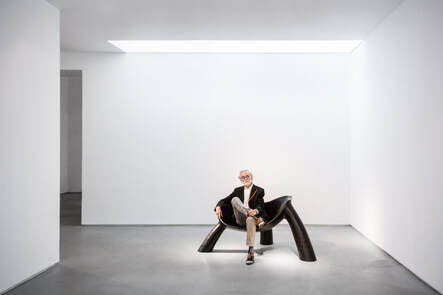 Portrait of Wendell Castle seated on 'Long Night' (2011), 2013. Photo courtesy of Friedman Benda and the artist; photo by Adrien Millot.
Portrait of Wendell Castle seated on 'Long Night' (2011), 2013. Photo courtesy of Friedman Benda and the artist; photo by Adrien Millot.
In Memoriam: Wendell Castle (1932–2018)
An essay for "Views" the blog published by the Museum of Arts and Design (February 28, 2018).
Castle’s contribution to modern and contemporary craft is immense, though perhaps not yet measurable. No doubt his legacy will be remembered, studied, and influential within the design and craft field for decades (if not more) to come. His career developed in parallel with MAD’s own history, from his career-launching inclusion in Young Americans 1962 to Wendell Castle Remastered (2015), an exhibition of his newest body of work alongside his iconic stack-laminated furniture, which toured to the Memorial Art Gallery in Rochester, New York, near Castle’s home, in the fall of 2017. We are grateful to have had this last opportunity to share his work and celebrate an artist so near and dear to our institution.
Read more →
An essay for "Views" the blog published by the Museum of Arts and Design (February 28, 2018).
Castle’s contribution to modern and contemporary craft is immense, though perhaps not yet measurable. No doubt his legacy will be remembered, studied, and influential within the design and craft field for decades (if not more) to come. His career developed in parallel with MAD’s own history, from his career-launching inclusion in Young Americans 1962 to Wendell Castle Remastered (2015), an exhibition of his newest body of work alongside his iconic stack-laminated furniture, which toured to the Memorial Art Gallery in Rochester, New York, near Castle’s home, in the fall of 2017. We are grateful to have had this last opportunity to share his work and celebrate an artist so near and dear to our institution.
Read more →
 Resting crane minaudière with rhinestones, 1970. Photo by Gary Mamay; courtesy the Leiber Collection.
Resting crane minaudière with rhinestones, 1970. Photo by Gary Mamay; courtesy the Leiber Collection.
"Making Judith Leiber"
An essay for "Views" the blog published by the Museum of Arts and Design (July 10, 2017).
The legendary name of Judith Leiber is synonymous with tiny, sparkling handbags in outrageous shapes like asparagus stalks and penguins. But many who are familiar with her Swarovski-studded oeuvre don’t know the story of the woman behind the handbags, who had the determination and talent to become a master craftswoman with a fascinating career.
Read more →
An essay for "Views" the blog published by the Museum of Arts and Design (July 10, 2017).
The legendary name of Judith Leiber is synonymous with tiny, sparkling handbags in outrageous shapes like asparagus stalks and penguins. But many who are familiar with her Swarovski-studded oeuvre don’t know the story of the woman behind the handbags, who had the determination and talent to become a master craftswoman with a fascinating career.
Read more →

"Pedagogical Powerhouse: At the half-century mark, the influential glass art program at the Rhode Island School of Design shows no signs of giving up its leading role"
Published by GLASS: The UrbanGlass Quarterly (Spring 2017).
While work made in the Studio Glass tradition gets a bad name today, the origins of the movement were ripe with the experimentation that permeated the founding of the earliest glass programs at the University of Wisconsin–Madison, the Rhode Island School of Design (RISD), and the Pilchuck Glass School (Pilchuck).
Read more →
Published by GLASS: The UrbanGlass Quarterly (Spring 2017).
While work made in the Studio Glass tradition gets a bad name today, the origins of the movement were ripe with the experimentation that permeated the founding of the earliest glass programs at the University of Wisconsin–Madison, the Rhode Island School of Design (RISD), and the Pilchuck Glass School (Pilchuck).
Read more →
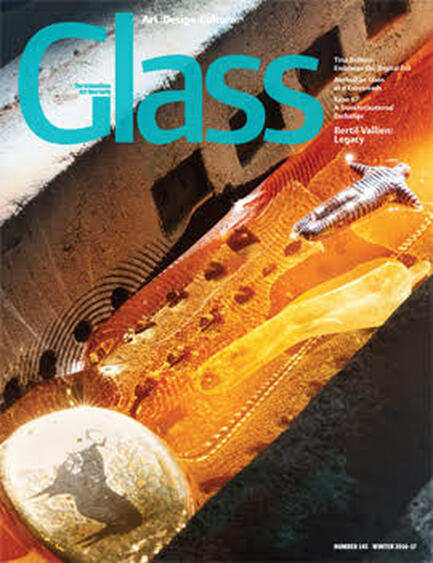
"Judith Schaechter: The Life Ecstatic"
Published by GLASS: The UrbanGlass Quarterly (Winter 2016/17).
Judith Schaechter’s stained glass windows feature icons of contemporary life. Rather than saints their central figures are women in various states of conflict and transcendence. Images fit to illustrate a twenty-first century retelling of Dante’s Divine Comedy.
Read more → (TK)
Published by GLASS: The UrbanGlass Quarterly (Winter 2016/17).
Judith Schaechter’s stained glass windows feature icons of contemporary life. Rather than saints their central figures are women in various states of conflict and transcendence. Images fit to illustrate a twenty-first century retelling of Dante’s Divine Comedy.
Read more → (TK)
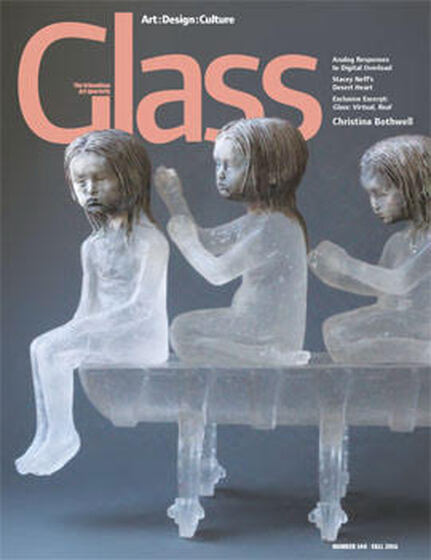
"Gerhard Richter Paintings"
Published by GLASS: The UrbanGlass Quarterly (Fall 2016).
Richter’s work is very emotive, a quality more evident if you hear him speak about the work. It’s almost as if he helps the artworks create themselves, giving a little bit of himself to each until they are content. For the abstract paintings--which he speaks about most frequently--he begins with the brush, streaking color across the canvas in bright swatches.
Read more →
Published by GLASS: The UrbanGlass Quarterly (Fall 2016).
Richter’s work is very emotive, a quality more evident if you hear him speak about the work. It’s almost as if he helps the artworks create themselves, giving a little bit of himself to each until they are content. For the abstract paintings--which he speaks about most frequently--he begins with the brush, streaking color across the canvas in bright swatches.
Read more →
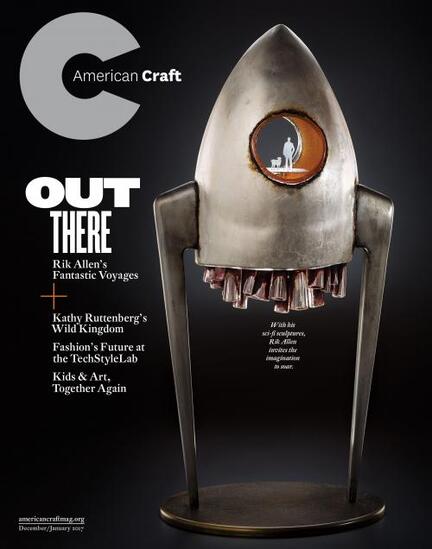
"Voices"
I was interviewed for the "Voices" section of American Craft Magazine (December/January 2017) and later featured on their website.
I was interviewed for the "Voices" section of American Craft Magazine (December/January 2017) and later featured on their website.
"Bookmarks"
I was interviewed for the "Bookmarks" section of American Craft Council blog (March 2016).
Read more →
I was interviewed for the "Bookmarks" section of American Craft Council blog (March 2016).
Read more →

"Christina Poblador: Venus Freed"
Published by GLASS: The UrbanGlass Quarterly (Summer 2016).
Venus Freed is comprised a collection of blown glass objects and flowers, and found materials--such as wood and sea shells--that reference the myth of the Filipino ylang ylang flower. As the press release states, Poblador laments the exploitation of the flower--both as a cultural icon, and ecologically through the harvesting of the plant--by Western perfumiers and their negligence in attributing the ylang ylang to it’s country of origin.
Read more →
Published by GLASS: The UrbanGlass Quarterly (Summer 2016).
Venus Freed is comprised a collection of blown glass objects and flowers, and found materials--such as wood and sea shells--that reference the myth of the Filipino ylang ylang flower. As the press release states, Poblador laments the exploitation of the flower--both as a cultural icon, and ecologically through the harvesting of the plant--by Western perfumiers and their negligence in attributing the ylang ylang to it’s country of origin.
Read more →

"Jeff Zimmerman"
Published by GLASS: The UrbanGlass Quarterly (Spring 2016).
Jeff Zimmerman’s self-titled exhibition at R & Company in New York City’s Tribeca is indicative of the artist’s relationship with his gallery. I say this to mean not that the artist is influenced by his representation, but that their relationship is based in mutual interest in the designed object—in Zimmerman’s case the extraordinarily well-crafted object—and that his work would not be well placed outside of a design context.
Read more →
Published by GLASS: The UrbanGlass Quarterly (Spring 2016).
Jeff Zimmerman’s self-titled exhibition at R & Company in New York City’s Tribeca is indicative of the artist’s relationship with his gallery. I say this to mean not that the artist is influenced by his representation, but that their relationship is based in mutual interest in the designed object—in Zimmerman’s case the extraordinarily well-crafted object—and that his work would not be well placed outside of a design context.
Read more →
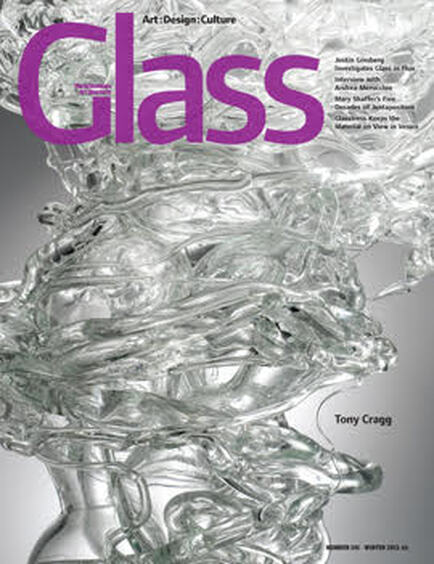
"Josiah McElheny: Paintings"
Published by GLASS: The UrbanGlass Quarterly (Winter 2015/16).
Josiah McElheny’s newest series of work, none of it two-dimensional paint on canvas, is provocatively titled Paintings. This irreverent naming is consistent for an artist who has built his career on cleverly reimagined histories, and this newest work adds to a trajectory of scholarly art making.
Read more →
Published by GLASS: The UrbanGlass Quarterly (Winter 2015/16).
Josiah McElheny’s newest series of work, none of it two-dimensional paint on canvas, is provocatively titled Paintings. This irreverent naming is consistent for an artist who has built his career on cleverly reimagined histories, and this newest work adds to a trajectory of scholarly art making.
Read more →

"Erica Rosenfeld: Like Remembering a Dream the Day After . . ."
Published by GLASS: The UrbanGlass Quarterly (Fall 2015).
As glass artists, or artists who happen to work with glass, delve further into the world of mixed media, and as designers and artists who don’t traditionally work with glass try their hand at the material through programs like GlassLab at the Corning Museum of Glass, the sometimes-insular quality of the glass art world is beginning to break down.
Read more →
Published by GLASS: The UrbanGlass Quarterly (Fall 2015).
As glass artists, or artists who happen to work with glass, delve further into the world of mixed media, and as designers and artists who don’t traditionally work with glass try their hand at the material through programs like GlassLab at the Corning Museum of Glass, the sometimes-insular quality of the glass art world is beginning to break down.
Read more →

"Charles J. Connick: Beyond Gothic"
Published by the Journal of Stained Glass (2013), the peer-reviewed journal of the British Society of Master Glass Painters.
This article expands upon my lecture for the American Glass Guild to explore Charles Connick's place in modern art history and Arts and Crafts practice.
Read more →
Published by the Journal of Stained Glass (2013), the peer-reviewed journal of the British Society of Master Glass Painters.
This article expands upon my lecture for the American Glass Guild to explore Charles Connick's place in modern art history and Arts and Crafts practice.
Read more →

"Charles Jay Connick: Beyond Gothic"
An essay and lecture for the 2013 American Glass Guild conference publication.
This essay and lecture explore the many Charles Connick's Arts and Crafts stained glass designs, and the ways in which he draws inspiration from twelfth-and-thirteenth-century French stained glass, while simultaneously forging a modern, American style.
Read more →
An essay and lecture for the 2013 American Glass Guild conference publication.
This essay and lecture explore the many Charles Connick's Arts and Crafts stained glass designs, and the ways in which he draws inspiration from twelfth-and-thirteenth-century French stained glass, while simultaneously forging a modern, American style.
Read more →

